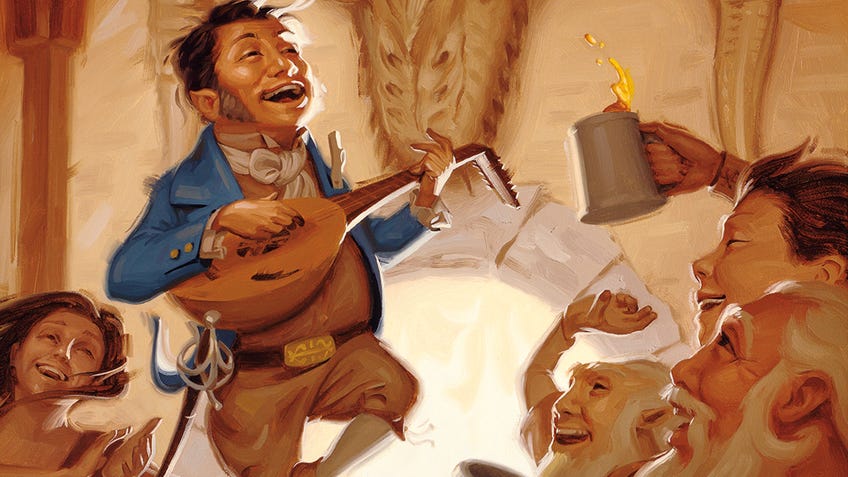10 easily forgotten Dungeons & Dragons 5E rules you’re getting wrong - and why you should be using them
Mind Strayer.
Dungeons & Dragons 5E is a complicated game. Not many other tabletop RPGs require a central rulebook, two further compendiums and a scattering of supplements and designer updates to be current, nor bring with them a few decades’ worth of previous editions that have moved the goalposts since.
It’s as natural as a one or a 20, then, that some of the roleplaying game’s trickier corners get forgotten between rollicking adventures; whether that’s the exact unladen carrying capacity of your average commoner (300 pounds, impressively) or how to roll an attack (a d20? Are you sure?)
So, to help spare your blushes, we’ve delved into the Forgotten Rules universe (next door to the D&D setting of the Forgotten Realms) to dig out the top ten Dungeons & Dragons 5E laws you may have un-remembered.
A word of warning: your mileage may vary, and your dungeon master may well have their own ways of litigating some of these forgotten rules in clever, elegant or hilarious ways. And in any case, the Rule of Cool may win out. So always check in with them and your group before ‘rules lawyering’.
Cheating death - critically
When your character drops to zero hit points - and their merry dance with Death begins - you start rolling death saving throws. Three failures (below a 10 on a d20, with no modifiers) and they’re brown bread; three successes (a 10 or above), and they are ‘stabilised’, unconscious but on 0hp. Like a really nasty hangover.
Rolling a natural one on that check means two failures, meaning death is only one sub-par dice chuck away. But a natural 20 on a death saving roll means they gain one hit point and spring back into action as if nothing happened - no matter what else they rolled.
Jack of All Trades… including initiative
This is a very specific rule but one that your bard player will be overjoyed to hear: we already know that, starting at second level, they can add half their proficiency bonus, rounded down, to any ability check made that does not already include their proficiency bonus.
Most bards will add this bonus to their usual skill checks - athletics, insight, animal handling and the like - with glee. But they can also add their Jack of All Trades bonus to their initiative roll at the start of combat, adding a +1 at second level (and going up from there).

Ranged problems
Ranged players, we’re giving you a two-for-one special here. First: if you are shooting and any enemy is adjacent to you (within 5ft), you make those attacks with disadvantage, no matter who you are targeting. Even if you feel like you’re channeling John Wick, bogies on your six (baddies behind you) will put you off that perfect shot.
There’s more bad news: second, if you want to ranged attack past another creature - whether friend or enemy - then your target will count as being in half cover and gain a +2 bonus to their AC and dexterity saving throws. Wanted-style bullet or arrow-curving is out too, I’m afraid. (You can work out AC in this Dungeons & Dragons character creation guide)
Doubling up - effects and hits points
This is a quick and easy one, and is more of a clarification of the rules as they exist: if you want to combine the effects of two spells or abilities that have an effect, positive or negative, on the target, then only the stronger one will have an effect.
This also applies to temporary hit points: you can’t stack up your short-term meatiness, and can only choose the larger value of your current value, or the newly gained temporary health pool..
Powerlifting and you
Carrying capacity is not the sexiest rule in D&D 5E, as it brings to life that part of other tabletop or video game RPGs that everyone loves to hate: inventory management.
But there’s an important part to bear in mind when it comes to incredible feats of strength. Your character’s carrying capacity (in pounds) is their strength score times 15 (or by 6.8 if you prefer the metric system). You can push, drag or lift up to twice that value at your full movement speed; if you try to drag or push more, you can only move at a speed of five feet. These values double for creatures in each size category above medium, and half for each category smaller.
Important? Perhaps not, but it can be devastating in combination with...

Exhausting your options
Exhaustion is an often-ignored ruleset in Dungeons & Dragons 5E but can be a fantastic way to add higher stakes to a wilderness mission, or added peril to a monster’s attacks or an ancient dungeon’s defenses.
Characters can gain a level of exhaustion if they are exposed to the elements, start starving or carry way too much for way too long. DMs usually call for a saving throw of the appropriate type, with a failure gaining a level of exhaustion. This starts at disadvantage on ability checks at level one, progressing through speed halved, then disadvantage on attack rolls and saving throws, then maximum hit points halved, before your speed is reduced to zero and, at stage six, death. These effects are cumulative, too, and are hard to shake off: a long rest will reduce your exhaustion level by one, but only if you have access to food and drink.
Spell Components - not just a shopping list
Most DMs lack the time or bookkeeping skills to stay entirely on top of material spell components, and rightly so: who wants to send their party on an epic shopping quest to acquire an adder’s stomach (worth eight gold) just so their ranger can cast Melf’s Acid Arrow?
But spell components can add an interesting element to your spellcasting and roleplaying, particularly when considering the verbal and somatic elements (saying words and making elaborate wizard gestures, respectively). And many status conditions, spells or unfortunate circumstances will make one of the two impossible - meaning players need to be more creative about how they cast them, and DMs more devious in how they can restrict spell-slinging in their next encounter.
Which leads us nicely into…

Concentration, concentration, concentration
Spell concentration is part of many of the most devastating, ongoing spells, and is a rule that represents your caster maintaining their cool while channeling mass destruction/healing/polymorphing your party’s gnome into an adult red dragon.
Much of the state is misunderstood, though: you can move and attack while normal while concentrating, for example. The status only breaks if you cast another spell that requires concentration, you fail a con save when taking damage (DC of 10 or half the damage you take, whichever is higher), you are incapacitated or die, or certain environmental effects force another con save (like a wave hitting the ship you’re on, or your character’s children mobbing them).
But wait! There’s more:
Get ready… concentrate!
Readying an action is a great way to hold an attack, spell or cool flip for a vital moment in a combat. But did you know that readying a spell requires you to maintain concentration for the duration?
Well, it does! So if you’re charging up your Fireball and your DM sends a horde of goblins your way to interrupt, you better roll well while they wail on your face. Else your cleverly-delayed pyrotechnics will end up doing very little.
Machine-gun spells
For the most part, players can only take a single action on each round of combat, which usually translates to a single attack, spell or attempt at pulling a lever. But some cheeky spells, such as Shield or Hunter’s Mark, have a cast time of a bonus action.
But before your greedy wizard eyes light up, there’s an important rule to remember: if you use a spell with a casting time of one bonus action, you can’t cast another spell during the same turn, except for a cantrip with a casting time of one action. However, if you were still interested in playing a wizard, you can learn to create one with this guide to the wizard class.
So, Misty Step into Firebolt? Fine. Misty Step into Magic Missile? No dice, amigo.








